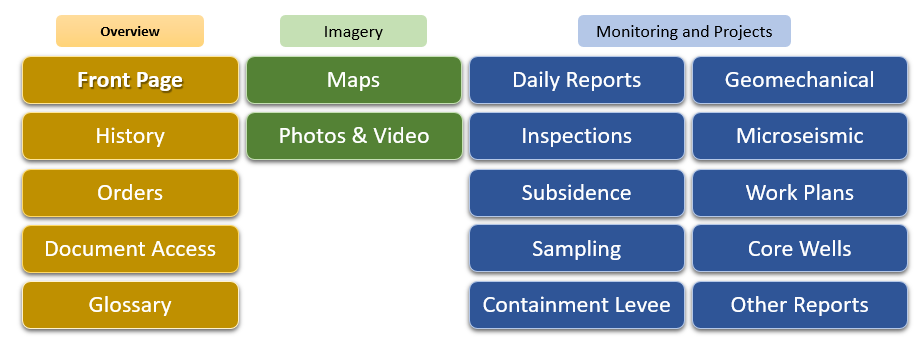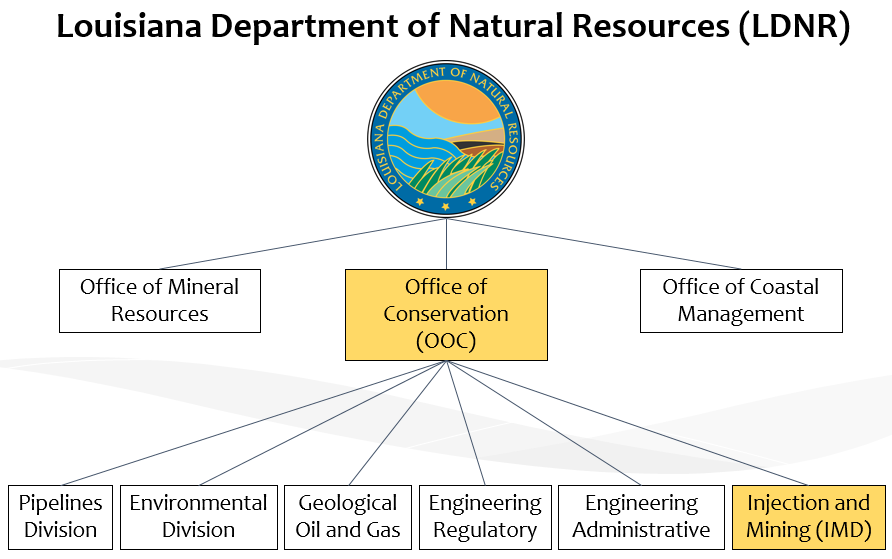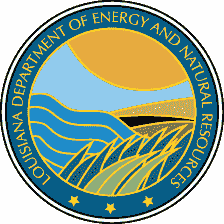Sulphur Mines Investigation
MAIN MENU:

GLOSSARY
LNDR Organization:

aquifer: a geologic formation, groups of formations, or part of a formation that is capable of yielding a significant amount of water to a well or spring.
API gravity: (American Petroleum Insitute gravity) the measure of how heavy or light a petroleum liquid is compared to water.
BBL: barrels (of crude oil), equivalent to 42 US gallons liquid volume
blanket material: sometimes referred to as a pad. The blanket material is a fluid or gas placed within a cavern that is lighter than the water in the cavern and will not dissolve the salt or any mineral impurities that may be contained within the salt. The function of the blanket is to prevent unwanted leaching of the cavern roof, prevent leacing of salt from around the cemented casing, and to protect the cemented casing from internal corrosion. Blanket material typically consists of crude oil, diesel, mineral oil, or some fluid or gas possessing similar noncorrosive, non-solvent, low density properties. The blanket material is placed against the cavern roof, within the cavern neck, and between the cavern's outermost hanging string and innermost cemented casing.
borehole: a hole made in the earth by a drilling rig
brine: water within a salt cavern that is saturated partially or completely with salt.
cap rock: the porous and permeable strata immediately overlying all or part of the salt stock of some salt structures; typically composed of anhydrite, gypsum, limestone, and occasionally sulfur.
casing: metallic pipe placed and cemented in the wellbore for the purpose of supporting the sides of the wellbore and to act as a barrier preventing subsurface migration of fluids out of or into the wellbore.
Casing Inspection Log (CIL): a suite of logs used to detect deformation, physical wear, and corrosion of the cased borehole
catastrophic collapse: the sudden failure of the overlying strata caused by the removal or otherwise weakening of underlying sediments.
cavern neck: the uncased wellbore between the deepest casing shoe and the cavern roof, if present.
cavern roof: the uppermost part of a cavern being just below the neck of the wellbore. The shape of the salt cavern roof may be flat or domed.
cementing: the operation (either primary, secondary, or squeeze) whereby a cement slurry is pumped into a drilled hole and/or forced behind the casing.
flaring: the burning of natural gas for safety reasons or when there is no way to transport the gas to market or use the gas for other beneficial purposes (such as EOR or reservoir pressure maintenance)
formation: a rock layer which has distinct characteristics (such as rock type, geologic age, etc.)
hanging string: casing whose weight is supported at the wellhead and hangs vertically in a larger cemented casing or another larger hanging string.
leaching: the process of introducing an under-saturated fluid into a salt cavern thereby dissolving additional salt and increasing the volume of the salt cavern.
mechanical integrity: an injection well has mechanical integrity if there is no significant leak in the casing, tubing, or packer and there is no significant fluid movement into an underground source of drinking water through vertical channels adjacent to the injection well bore.
Mechanical Integrity Test (MIT): a test performed to determine whether a cavern or well has mechanical integrity, also called a Mechanical Integrity Pressure and Leak Test
migrating: any movement of fluids by leaching, spilling, discharging, or any other uncontained or uncontrolled manner, except as allowed by law, regulation, or permit.
open borehole: the portion of the drilled well bore that is uncased at any point in time.
operator: the person recognized by the Office of Conservation as being responsible for the physical operation of the facility or activity subject to regulatory authority under these rules and regulations.
owner: the person recognized by the Office of Conservation as owning the facility or activity subject to regulatory authority under these rules and regulations.
permit: an authorization, license, or equivalent control document issued by the commissioner to implement the requirements of these regulations. Permit includes, but is not limited to, area permits and emergency permits. Permit does not include UIC authorization by rule or any permit which has not yet been the subject of final agency action, such as a draft permit.
produced water: liquids and suspended particulate matter that is obtained by processing fluids brought to the surface in conjunction with the recovery of oil and gas from underground geologic formations, with underground storage of hydrocarbons, or with solution-mining for brine.
Public Water System: a system for the provision to the public of piped water for human consumption, if such system has at least 15 service connections or regularly serves at least 25 individuals. Such term includes:
- any collection, treatment, storage, and distribution facilities under control of the operator of such system and used primarily in connection with such system; and
- any collection or pretreatment storage facilities not under such control which are used primarily in connection with such system.
salt cavern: artificial (manmade) cavities in underground salt formations, which are created by dissolving rock salt by injecting hot water. Often used to store oil, natural gas, and petroleum products.
salt dome: a diapiric, typically circular structure that penetrates, uplifts, and deforms overlying sediments as a result of the upward movement of a salt stock in the subsurface. Collectively, the salt dome includes the salt stock and any overlying uplifted sediments.
salt stock: a typically cylindrical formation composed chiefly of an evaporite mineral that forms the core of a salt dome. The most common form of the evaporite mineral is halite known chemically as sodium chloride (NaCl). Cap rock shall not be considered a part of the salt stock.
subsidence: the downward settling of the Earth's surface with little or no horizontal motion in response to natural or manmade subsurface actions.
schedule of compliance: a schedule or remedial measures included in a permit, including an enforceable sequence of interim requirements (for example, actions, operations, or milestone events) leading to compliance with the act and these regulations.
solution-mining cavern: a cavity created within the salt stock by dissolution with water.
solution-mining well: a well which injects for extraction of minerals including:
- mining of sulfur by the Frasch process;
- in situ production of uranium or other metals.
3. solution mining of salts or potash.
surface casing: steel pipe placed inside the conductor casing in the borehole which extends below, and is protective of, the USDW and other shallow geologic formations.
UIC: the Louisiana State Underground Injection Control Program.
unauthorized discharge: a continuous, intermittent, or one-time discharge, whether intentional or unintentional, anticipated or unanticipated, from any permitted or unpermitted source which is in contravention of any provision of the Louisiana Environmental Quality Act (R.S. 30:2001 et seq.) or of any permit or license terms and conditions, or of any applicable regulation, compliance schedule, variance, or exception of the Commissioner of Conservation.
Underground Source of Drinking Water (USDW): an aquifer or its portion:
- which supplies any public water system; or
- which contains a sufficient quantity of groundwater to supply a public water system; and
- currently supplies drinking water for human consumption; or
- contains fewer than 10,000 mg/1 total dissolved solids; and which is not an exempted aquifer.
well: a bored, drilled, or driven shaft whose depth is greater than the largest surface dimension; or, a dug hole whose depth is greater than the largest surface dimension; or, a subsurface fluid distribution system.
well plug: a fluid-tight seal installed in a borehole or well to prevent movement of fluids.
workover: to perform one or more of a variety of remedial operations on an injection well, such as cleaning, perforation, changing tubing, deepening, squeezing, plugging back, etc.
See also:
AAPG Wiki (Glossary of Oil & Gas terms)
ConocoPhillips Glossary of Oil and Gas Terms
